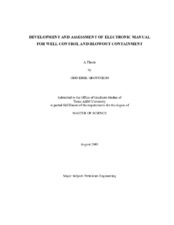| dc.description.abstract | DEA ?? 63, Floating Vessel Blowout Control is a blowout containment study which was
completed in 1990, and it did not include discussions about operations in the water
depths we currently operate in. As offshore drilling is continuously moving into deeper
and deeper waters, a need to further investigate well control and blowout containment in
ultradeep water has arisen.
This project describes the development and assessment of an electronic cross-reference
tool for well control and blowout containment, with added focus on ultradeep water
operations. The approach of this manual is fully electronic, thus being able to serve the
needs of the engineer/driller with greater ease in both pre-planning and in a stressful onthe-
job setting.
The cross-reference is a manual for the state of the art in well control and blowout
containment methodology. It provides easy-to-use topical organization by categories and
subcategories, and aims at providing clear links between symptoms, causes, and
solutions. Clear explanations to complicated issues are provided, and confirmation of
applicable blowout intervention procedures, be it conventional or unconventional, are
discussed.
Human error and equipment failure are the causes of blowouts, and they are bound to
happen in an ultradeep water environment. Well control events are harder to detect andhandle in ultradeep water, and quick reaction time is essential. After detection and shutin,
the Driller??s method is the preferred circulation method in ultradeep water, due to its
responsiveness and simplicity. In case kick handling is unsuccessful, contingency plans
should be in place to handle a potential blowout. If a blowout does occur, and the
blowing well does not self-kill through bridging, a dynamic kill through relief well
intervention is likely to be necessary, as underwater intervention is difficult in ultradeep
water. With new ultradeep water drilling technologies providing potential for increased
performance, alternative well control methods might be necessary. Along with these new
technologies follow new unfamiliar procedures, and proper education and training is
essential. | en |


